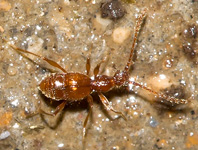Abstract
The monotypic Perdita subgenus Xeromacrotera Timberlake is currently known only from the male sex. Here, the female of Perdita (Xeromacrotera) cephalotes (Cresson, 1878) is associated, resulting in two new junior synonyms of P. (X.) cephalotes: Perdita (Procockerellia) excellens Timberlake, 1958, new synonym and Perdita (Cockerellia) autumnalis Timberlake, 1977, new synonym. The true number of maxillary palpi are reported, and updated subgeneric and species diagnoses are provided. In addition, Perdita boharti Portman & Griswold, new name, is designated as a replacement name for the primary junior homonym P. bohartorum Parker, 1983 (not P. bohartorum Timberlake, 1956) and is assigned to the related subgenus Cockerellia Ashmead.
References
Ashmead, W.H. (1897) Some new genera of bees. Pysche, 8, 282–285.
http://dx.doi.org/10.1155/1898/70320Cockerell, T.D.A. (1896) The bees of the genus Perdita F. Smith. Proceedings of the Academy of Natural Sciences of Philadelphia, 48, 25–107.
Cockerell, T.D.A. & Porter, W. (1899) Contributions from the New Mexico Biological Station—VII. Observations on bees, with descriptions of new genera and species. Annals and Magazine of Natural History, 7 (4), 403–421.
http://dx.doi.org/10.1080/00222939908678225Cresson, E.T. (1878) Descriptions of new North American Hymenoptera in the collection of the American Entomological Society. Transactions of the American Entomological Society, 7, 61–136.
Danforth, B. (1996) Phylogenetic analysis and taxonomic revision of the Perdita subgenera Macrotera, Macroteropsis, Macroterella, and Cockerellula (Hymenoptera: Andrenidae). The University of Kansas Science Bulletin, 55 (16), 635–692.
Michener, C.D. (2007) The bees of the world, Second Edition. Johns Hopkins University Press, Baltimore and London, 953 pp.
Nesom, G.L. & Baird, G.I. (1993) Completion of Ericameria (Asteraceae: Astereae), diminution of Chrysothamnus. Phytologia, 75 (1), 74–93.
Parker, F.D. (1983) A new Perdita from Utah’s San Rafael Desert (Hymenoptera: Andrenidae). Pan-Pacific Entomologist, 59 (1–4), 229–232.
Smith, F. (1853) Catalogue of hymenopterous insects in the collection of the British Museum, Part 1. Andrenidae and Apidae. Trustees of the British Museum, London, 197 pp.
Timberlake, P.H. (1954) A revisional study of the bees of the genus Perdita F. Smith, with special reference to the fauna of the Pacific Coast, Part I. University of California Publications in Entomology, 9 (6), 345–432.
Timberlake, P.H. (1956) A revisional study of the bees of the genus Perdita F. Smith, with special reference to the fauna of the Pacific Coast, Part II. University of California Publications in Entomology, 11 (5), 247–350.
Timberlake, P.H. (1958) A revisional study of the bees of the genus Perdita F. Smith, with special reference to the fauna of the Pacific Coast, Part III. University of California Publications in Entomology, 14 (5), 303–410.
Timberlake, P.H. (1960) A revisional study of the bees of the genus Perdita F. Smith, with special reference to the fauna of the Pacific Coast, Part V. University of California Publications in Entomology, 17 (1), 1–156.
Timberlake, P.H. (1977) Descriptions of new species of Perdita (Hymenoptera, Apoidea) in the collection of the California Academy of Sciences. Proceedings of the California Academy of Sciences, 41 (10), 281–295.

